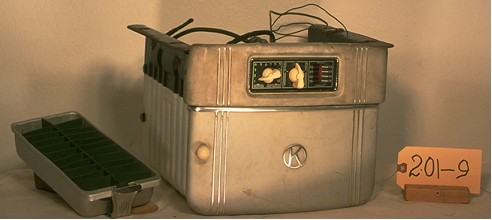Refrigerating and Air Conditioning Evaporators – Household
Gleaming white porcelain finish; full back cooling unit with door in brushed aluminium ( a new designer material of the mid 30’s) with a classic “K” Kelvinator insignia in modern design idiom.
Technical Significance:
See Technological Significance documentation for THOC-HVACR 014, 015 and 016. Like the above, this historical artifact of the Canadian HVACR industry is a remarkable icon of its time, marking a dramatic change in engineering, concepts, manufacturing and styling, as the industry geared up to move well beyond its embryonic development years of the 1920’s. Of special note is the level of automation and refrigeration system regulation reflected here, in remote bulb temperature controlling, defrost control and motor over load protection (See also historical artifacts THOC-HVACR Group 7.00 ). Seen here are the early manifestations of engineering thought in the practical application of what would become the cybernetic revolution of the 40’s and 50’s, in which mechanical and electrical systems were conceived as purposeful, self-regulating and self-directing entities.
Here, too, the unprepared public would be faced, most for the first time, with a myriad of switches and buttons (three), arrayed on a control panel (not included), which they were expected to understand and use effectively – most did not. The local refrigeration salesman and serviceman, the support network of the times, were constantly on call, if the householder found melted ice-cream, and other dripping contents on opening the refrigerator.
Here, then, are the early manifestations, realised in the engineering concepts and hardware of the period, of the on-coming revolution in the processing of meaningful, purposeful, information through feedback loops. (See “Modern Systems Research for the Behavioral Scientist, W. Buckley, 1968) .
Industrial Significance:
This offering was a significant attempt by Kelvinator and the Canadian refrigeration industry to improve system cooling and thermodynamic efficiencies, reduce manufacturing costs and progressively automate and regulate their systems better. The industry was investing heavily in new materials, construction and manufacturing technologies, in order to capture the interests of a second market buyers market.


